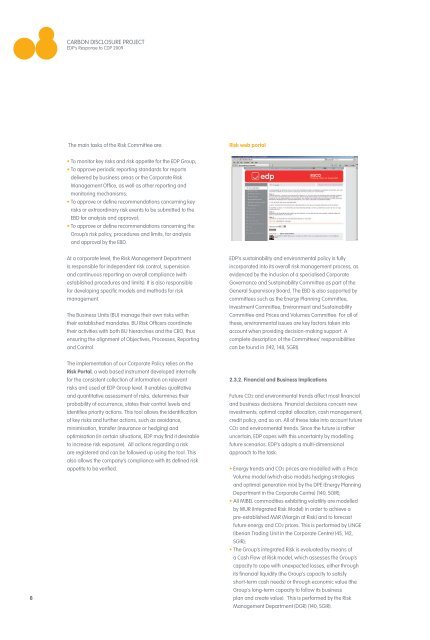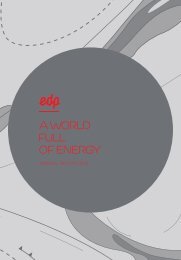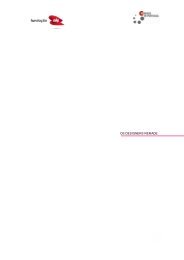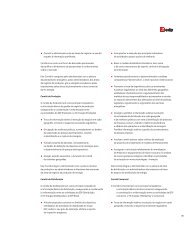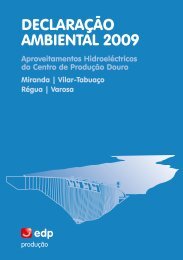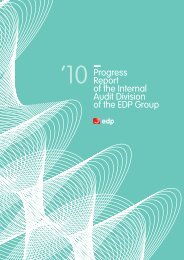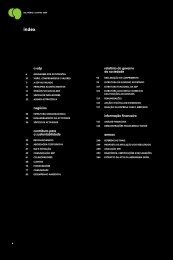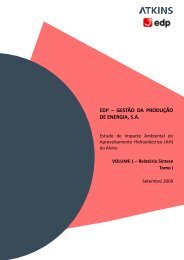CARBON DISCLOSURE PROJECT - EDP
CARBON DISCLOSURE PROJECT - EDP
CARBON DISCLOSURE PROJECT - EDP
Create successful ePaper yourself
Turn your PDF publications into a flip-book with our unique Google optimized e-Paper software.
8<br />
<strong>CARBON</strong> <strong>DISCLOSURE</strong> <strong>PROJECT</strong><br />
<strong>EDP</strong>’s Response to CDP 2009<br />
The main tasks of the Risk Committee are:<br />
• To monitor key risks and risk appetite for the <strong>EDP</strong> Group;<br />
• To approve periodic reporting standards for reports<br />
delivered by business areas or the Corporate Risk<br />
Management Office, as well as other reporting and<br />
monitoring mechanisms;<br />
• To approve or define recommendations concerning key<br />
risks or extraordinary risk events to be submitted to the<br />
EBD for analysis and approval;<br />
• To approve or define recommendations concerning the<br />
Group’s risk policy, procedures and limits, for analysis<br />
and approval by the EBD.<br />
At a corporate level, the Risk Management Department<br />
is responsible for independent risk control, supervision<br />
and continuous reporting on overall compliance (with<br />
established procedures and limits). It is also responsible<br />
for developing specific models and methods for risk<br />
management.<br />
The Business Units (BU) manage their own risks within<br />
their established mandates. BU Risk Officers coordinate<br />
their activities with both BU hierarchies and the CRO, thus<br />
ensuring the alignment of Objectives, Processes, Reporting<br />
and Control.<br />
The implementation of our Corporate Policy relies on the<br />
risk portal, a web based instrument developed internally<br />
for the consistent collection of information on relevant<br />
risks and used at <strong>EDP</strong> Group level. It enables qualitative<br />
and quantitative assessment of risks, determines their<br />
probability of occurrence, states their control levels and<br />
identifies priority actions. This tool allows the identification<br />
of key risks and further actions, such as avoidance,<br />
minimisation, transfer (insurance or hedging) and<br />
optimisation (in certain situations, <strong>EDP</strong> may find it desirable<br />
to increase risk exposure). All actions regarding a risk<br />
are registered and can be followed up using the tool. This<br />
also allows the company’s compliance with its defined risk<br />
appetite to be verified.<br />
risk web portal<br />
<strong>EDP</strong>’s sustainability and environmental policy is fully<br />
incorporated into its overall risk management process, as<br />
evidenced by the inclusion of a specialised Corporate<br />
Governance and Sustainability Committee as part of the<br />
General Supervisory Board. The EBD is also supported by<br />
committees such as the Energy Planning Committee,<br />
Investment Committee, Environment and Sustainability<br />
Committee and Prices and Volumes Committee. For all of<br />
these, environmental issues are key factors taken into<br />
account when providing decision-making support. A<br />
complete description of the Committees’ responsibilities<br />
can be found in (142, 148, SGRI).<br />
2.3.2. Financial and Business Implications<br />
Future CO2 and environmental trends affect most financial<br />
and business decisions. Financial decisions concern new<br />
investments, optimal capital allocation, cash management,<br />
credit policy, and so on. All of these take into account future<br />
CO2 and environmental trends. Since the future is rather<br />
uncertain, <strong>EDP</strong> copes with this uncertainty by modelling<br />
future scenarios. <strong>EDP</strong>’s adopts a multi-dimensional<br />
approach to the task:<br />
• Energy trends and CO2 prices are modelled with a Price<br />
Volume model (which also models hedging strategies<br />
and optimal generation mix) by the DPE (Energy Planning<br />
Department in the Corporate Centre) (140, SGIR);<br />
• All MIBEL commodities exhibiting volatility are modelled<br />
by MUR (Integrated Risk Model) in order to achieve a<br />
pre-established MAR (Margin at Risk) and to forecast<br />
future energy and CO2 prices. This is performed by UNGE<br />
(Iberian Trading Unit in the Corporate Centre) (45, 142,<br />
SGIR);<br />
• The Group’s integrated Risk is evaluated by means of<br />
a Cash Flow at Risk model, which assesses the Group’s<br />
capacity to cope with unexpected losses, either through<br />
its financial liquidity (the Group’s capacity to satisfy<br />
short-term cash needs) or through economic value (the<br />
Group’s long-term capacity to follow its business<br />
plan and create value). This is performed by the Risk<br />
Management Department (DGR) (140, SGIR).


